Pattern Deep Region Learning for Crack Detection in Thermography Diagnosis System
Abstract
:1. Introduction
2. Materials and Methods
2.1. Introduction of ECPT System
2.2. Proposed Strategy for Detection
2.2.1. Thermal Spatial-Transient Patterns
2.2.2. Faster-RCNN for Cracks Identification
3. Results and Discussion
3.1. Sample Preparation and Experiments Setup
3.2. Results Analysis
- (1)
- Boundary information of experiment component impacts the output of the unsupervised method, owing to the similarity of the thermal pattern during the process of thermal diffusion;
- (2)
- The unsupervised method pays more attention on data with specific properties such as non-negativity or sparsity, in order to denoise or separate the distinctive data from the original data sequence, which shows an unsatisfied performance on data localization when multi-properties exists in crack information;
- (3)
- Projecting data into a high dimension space by a deep convolution neural network, in order to extract special feature structure from the spatial domain, has been proven to be essential to differentiate crack area from other, easily confused, areas.
- (1)
- Task-driven model with deep architecture gets prior knowledge through the training process and fuses the prior knowledge into parameters of the network in order to extract specific features through the convolution process to obtain the feature map;
- (2)
- The model with deep architecture obtains feature from multi-properties while unsupervised method based on limited properties assumed to be contained in defect information. The flaw detection on the welding line sample faced the primary problem that the flaw regions showed similar physical properties with some origins of the noise discussed above. The performance provided by the unsupervised method, based on limited properties or features, is more likely to be restricted, owing to feature extraction only from low-dimension space.
4. Conclusions and Future Work
Author Contributions
Funding
Acknowledgments
Conflicts of Interest
References
- Halmshaw, R. Non-Destructive Testing; Edward Arnold: London, UK, 1991. [Google Scholar]
- Hellier, C. Handbook of Nondestructive Evaluation; McGraw-Hill: New York, YN, USA, 2001. [Google Scholar]
- Bray, D.E.; McBride, D. Nondestructive Testing Techniques; NASA STI/Recon Technical Report A; NASA: Washington, DC, USA, 1992; Volume 93.
- Li, X.; Gao, B.; Woo, W.L.; Tian, G.Y.; Qiu, X.; Gu, L. Quantitative surface crack evaluation based on eddy current pulsed thermography. IEEE Sens. J. 2017, 17, 412–421. [Google Scholar] [CrossRef]
- Kalinichenko, N.P.; Kalinichenko, A.N.; Konareva, I.S. Reference specimens of nonmetallic materials for penetrant nondestructive testing. Russ. J. Nondestruct. Test. 2011, 47, 663–666. [Google Scholar] [CrossRef]
- Helifa, B.; Oulhadj, A.; Benbelghit, A.; Lefkaier, I.K.; Boubenider, F.; Boutassouna, D. Detection and measurement of surface cracks in ferromagnetic materials using eddy current testing. NDT E Int. 2006, 39, 384–390. [Google Scholar] [CrossRef]
- Ravan, M.; Sadeghi, S.H.H.; Moini, R. Neural network approach for determination of fatigue crack depth profile in a metal, using alternating current field measurement data. IET Sci. Meas. Technol. 2008, 2, 32–38. [Google Scholar] [CrossRef]
- Palumbo, D.; Galietti, U. Characterisation of steel welded joints by infrared thermographic methods. Quant. InfraRed Thermogr. J. 2014, 11, 29–42. [Google Scholar] [CrossRef]
- Palumbo, D.; Ancona, F.; Galietti, U. Quantitative damage evaluation of composite materials with microwave thermographic technique: Feasibility and new data analysis. Meccanica 2015, 50, 443–459. [Google Scholar] [CrossRef]
- Sophian, A.; Tian, G.Y.; Taylor, D.; Rudlin, J. A feature extraction technique based on principal component analysis for pulsed eddy current NDT. NDT E Int. 2003, 36, 37–41. [Google Scholar] [CrossRef]
- Zhu, Y.K.; Tian, G.Y.; Lu, R.S.; Zhang, H. A review of optical NDT technologies. Sensors 2011, 11, 7773–7798. [Google Scholar] [CrossRef] [PubMed]
- Gao, B.; Woo, W.L.; He, Y.; Tian, G.Y. Unsupervised sparse pattern diagnostic of defects with inductive thermography imaging system. IEEE Trans. Ind. Inform. 2016, 12, 371–383. [Google Scholar] [CrossRef]
- Gao, B.; Woo, W.L.; Tian, G.Y.; Zhang, H. Unsupervised diagnostic and monitoring of defects using waveguide imaging with adaptive sparse representation. IEEE Trans. Ind. Inform. 2016, 12, 405–416. [Google Scholar] [CrossRef]
- Wang, Y.; Gao, B.; Woo, W.L.; Tian, G.Y.; Maldague, X. Thermal Pattern Contrast Diagnostic of Micro Cracks with Induction Thermography for Aircraft Braking Components. IEEE Trans. Ind. Inform. 2018. [Google Scholar] [CrossRef]
- Pan, M.; He, Y.; Tian, G.Y.; Chen, D.; Luo, F. Defect characterisation using pulsed eddy current thermography under transmission mode and NDT applications. NDT E Int. 2012, 52, 28–36. [Google Scholar] [CrossRef]
- Avdelidis, N.P.; Hawtin, B.C.; Almond, D.P. Transient thermography in the assessment of defects of aircraft composites. NDT E Int. 2003, 36, 433–439. [Google Scholar] [CrossRef]
- Xu, Z.; Wu, X.; Li, J.; Kang, Y. Assessment of wall thinning in insulated ferromagnetic pipes using the time-to-peak of differential pulsed eddy-current testing signals. NDT E Int. 2012, 51, 24–29. [Google Scholar] [CrossRef]
- Cheng, L.; Gao, B.; Tian, G.Y.; Woo, W.L.; Berthiau, G. Impact damage detection and identification using eddy current pulsed thermography through integration of PCA and ICA. IEEE Sens. J. 2014, 14, 1655–1663. [Google Scholar] [CrossRef]
- Cvejic, N.; Bull, D.; Canagarajah, N. Region-based multimodal image fusion using ICA bases. IEEE Sens. J. 2007, 7, 743–751. [Google Scholar] [CrossRef] [Green Version]
- Bai, L.; Gao, B.; Tian, G.Y.; Woo, W.L.; Cheng, Y. Spatial and time patterns extraction of eddy current pulsed thermography using blind source separation. IEEE Sens. J. 2013, 13, 2094–2101. [Google Scholar] [CrossRef]
- Gao, B.; Bai, L.; Woo, W.L.; Tian, G.Y.; Cheng, Y. Automatic defect identification of eddy current pulsed thermography using single channel blind source separation. IEEE Trans. Instrum. Meas. 2014, 63, 913–922. [Google Scholar] [CrossRef]
- Gao, B.; Lu, P.; Woo, W.L.; Tian, G.Y.; Zhu, Y.; Johnston, M. Variational Bayesian Sub-group Adaptive Sparse Component Extraction for Diagnostic Imaging System. IEEE Trans. Ind. Electron. 2018, 65, 8142–8152. [Google Scholar] [CrossRef]
- Lu, P.; Gao, B.; Woo, W.L.; Li, X.; Tian, G.Y. Automatic Relevance Determination of Adaptive Variational Bayes Sparse Decomposition for Micro-Cracks Detection in Thermal Sensing. IEEE Sens. J. 2017, 17, 5220–5230. [Google Scholar] [CrossRef]
- Lu, P.; Gao, B.; Feng, Q.; Yang, Y.; Woo, W.L.; Tian, G.Y. Ensemble variational Bayes tensor factorization for super resolution of CFRP debond detection. Infrared Phys. Technol. 2017, 85, 335–346. [Google Scholar] [CrossRef]
- Benmoussat, M.S.; Guillaume, M.; Caulier, Y.; Spinnler, K. Automatic metal parts inspection: Use of thermographic images and anomaly detection algorithms. Infrared Phys. Technol. 2013, 61, 68–80. [Google Scholar] [CrossRef]
- Gao, B.; Li, X.; Woo, W.L.; Tian, G.Y. Physics-based image segmentation using first order statistical properties and genetic algorithm for inductive thermography imaging. IEEE Trans. Image Proc. 2018, 27, 2160–2175. [Google Scholar] [CrossRef] [PubMed]
- Girshick, R.; Donahue, J.; Darrell, T.; Malik, J. Rich feature hierarchies for accurate object detection and semantic segmentation. In Proceedings of the IEEE Conference on Computer Vision and Pattern Recognition, Columbus, OH, USA, 23–28 June 2014. [Google Scholar]
- Ren, S.; He, K.; Girshick, R.; Sun, J. Faster r-cnn: Towards real-time object detection with region proposal networks. In Proceedings of the 28th International Conference on Neural Information Processing Systems, Montreal, QC, Canada, 7–12 December 2015. [Google Scholar]
- Redmon, J.; Divvala, S.; Girshick, R.; Farhadi, A. You only look once: Unified, real-time object detection. In Proceedings of the IEEE Conference on Computer Vision and Pattern Recognition, Las Vegas, NV, USA, 27–30 June 2016. [Google Scholar]
- Salamon, J.; Bello, J.P. Deep convolutional neural networks and data augmentation for environmental sound classification. IEEE Signal Proc. Lett. 2017, 24, 279–283. [Google Scholar] [CrossRef]
- Wang, Y.; Gao, B.; Tian, G.; Woo, W.L.; Miao, Y. Diffusion and separation mechanism of transient electromagnetic and thermal fields. Int. J. Therm. Sci. 2016, 102, 308–318. [Google Scholar] [CrossRef]
- Schmidhuber, J. Deep learning in neural networks: An overview. Neural Netw. 2015, 61, 85–117. [Google Scholar] [CrossRef] [PubMed] [Green Version]
- LeCun, Y.; Bengio, Y.; Hinton, G. Deep learning. Nature 2015, 521, 436–444. [Google Scholar] [CrossRef] [PubMed]
- Sripragash, L.; Sundaresan, M.J. A normalization procedure for pulse thermographic nondestructive evaluation. NDT E Int. 2016, 83, 14–23. [Google Scholar] [CrossRef]
- Maldague, X.; Marinetti, S. Pulse phase infrared thermography. J. Appl. Phys. 1996, 79, 2694–2698. [Google Scholar] [CrossRef] [Green Version]
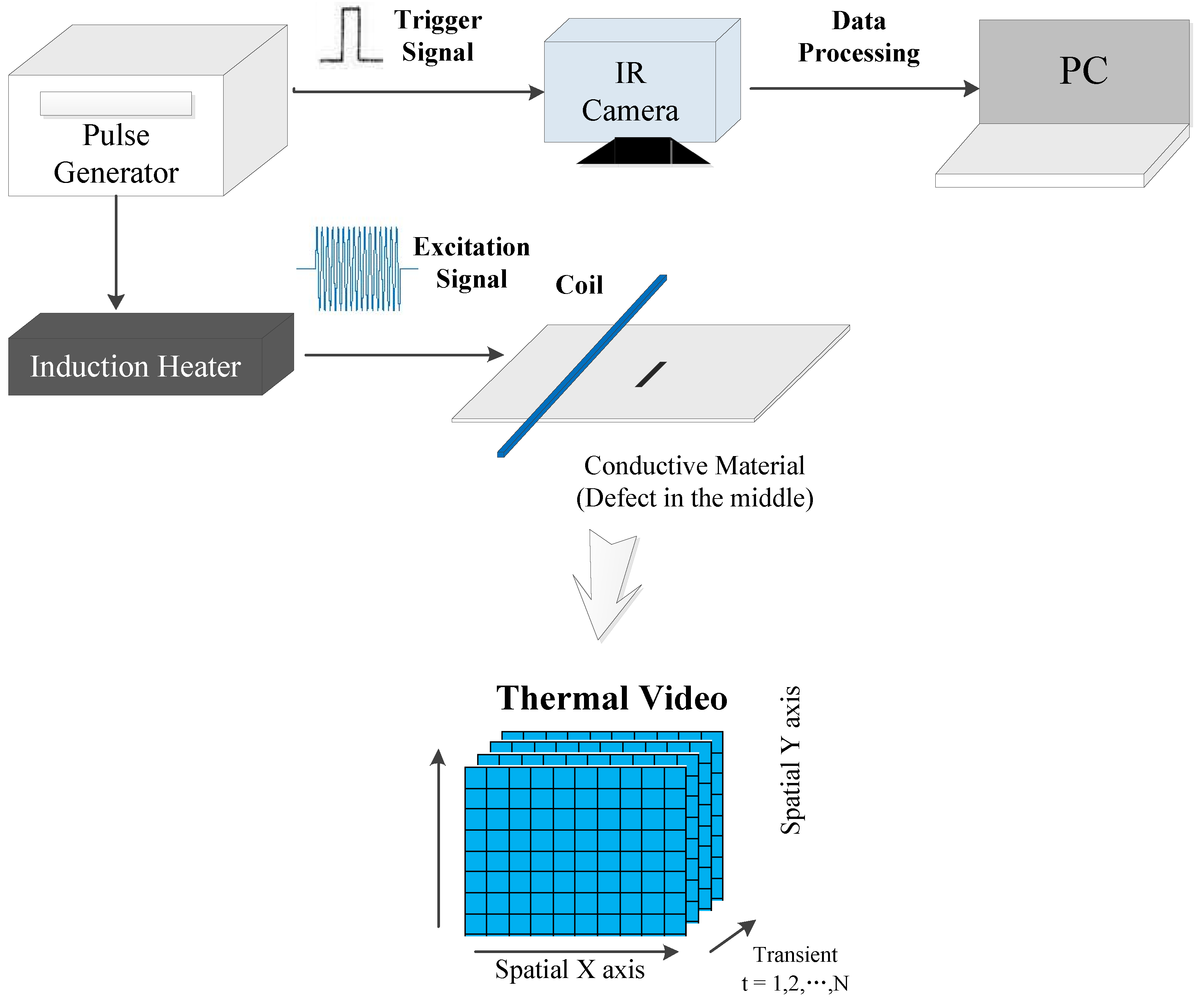
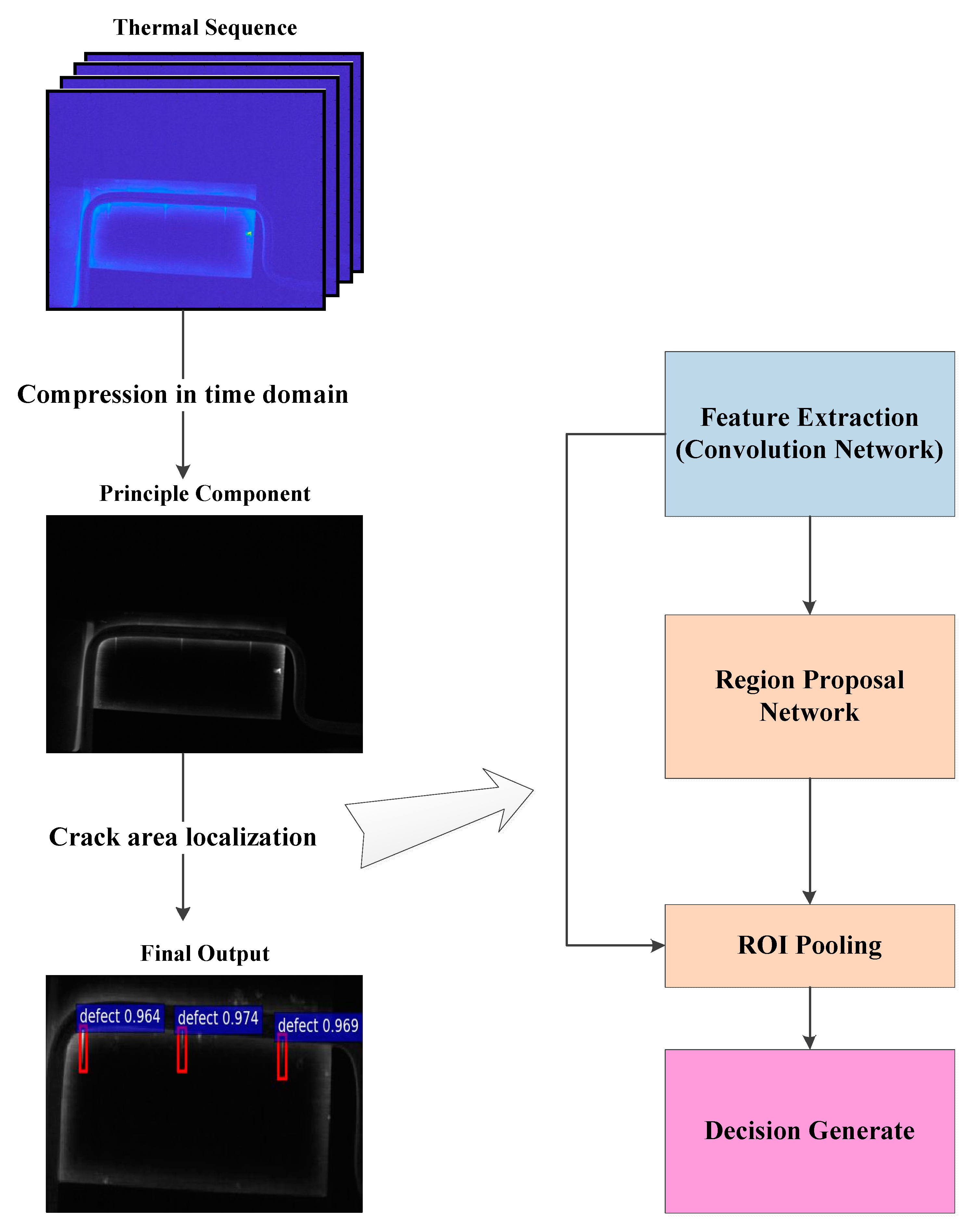
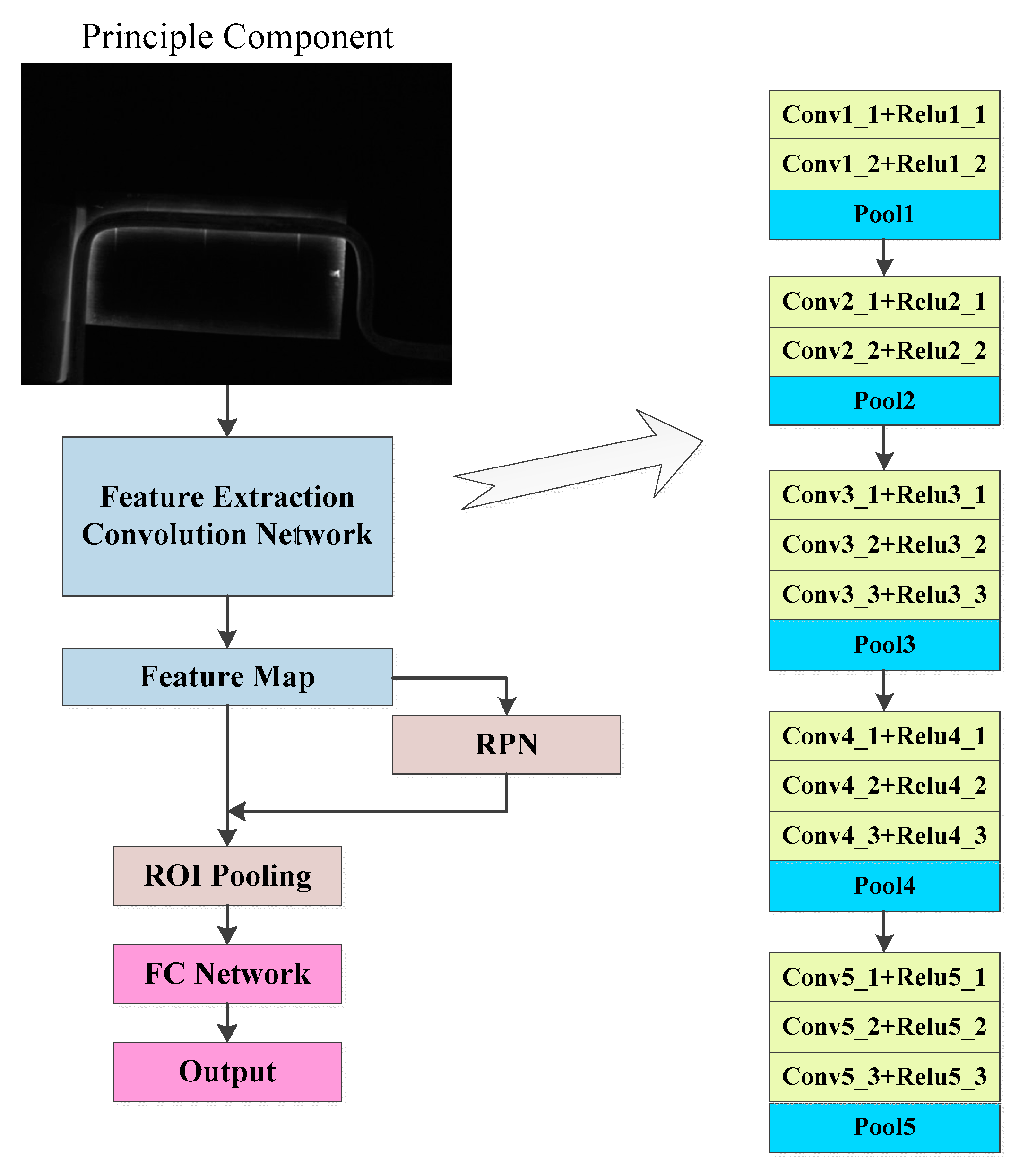
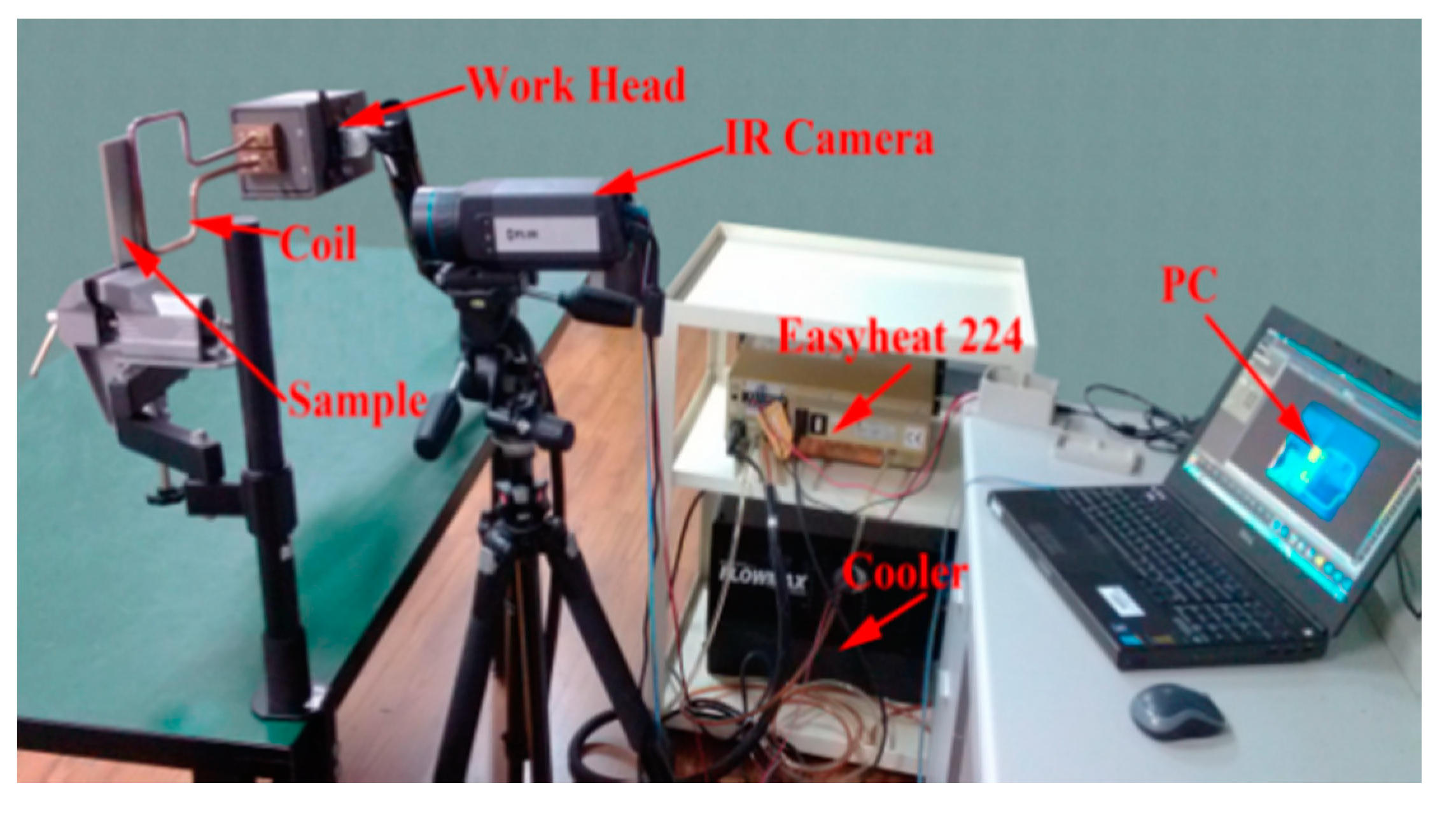
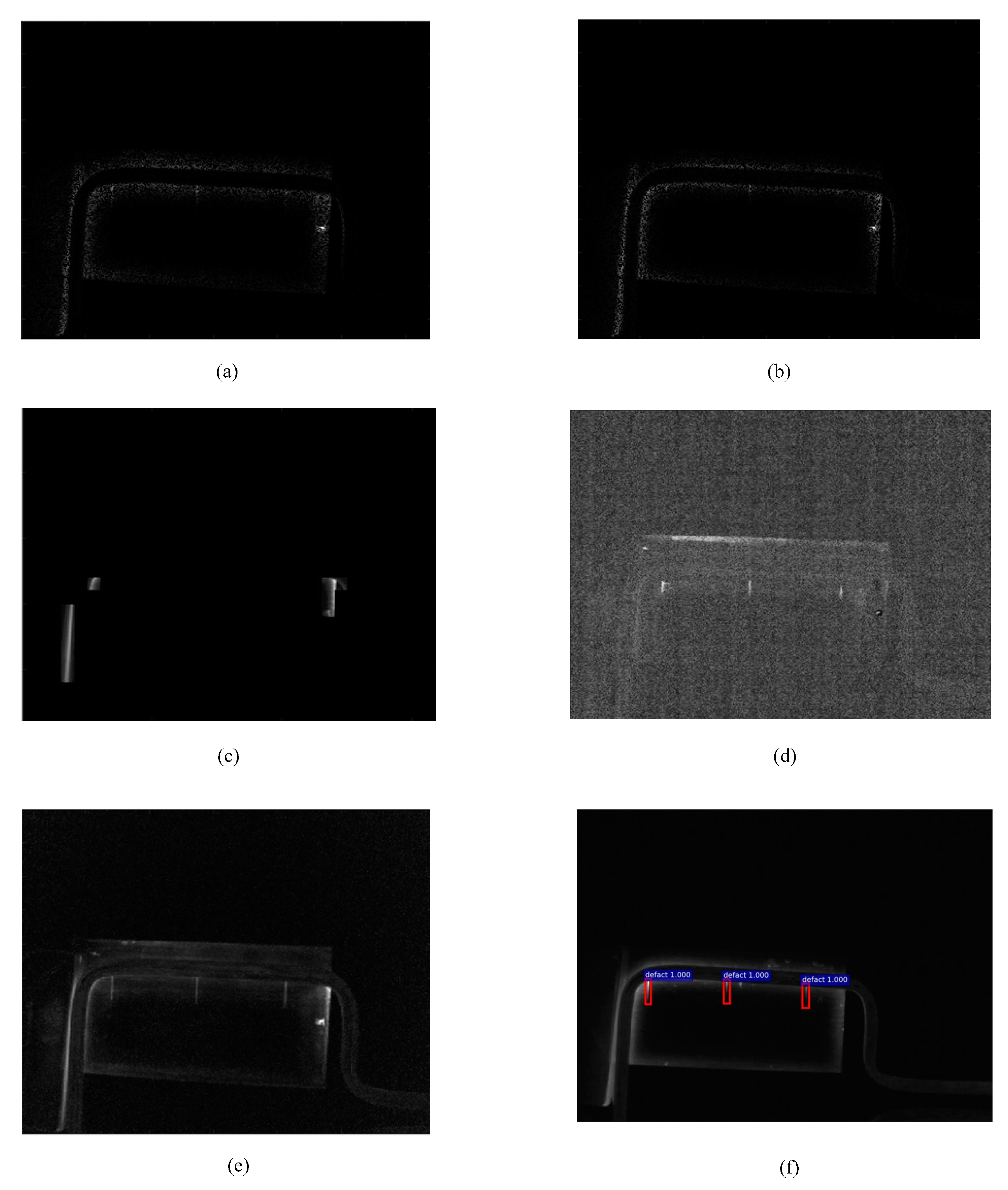
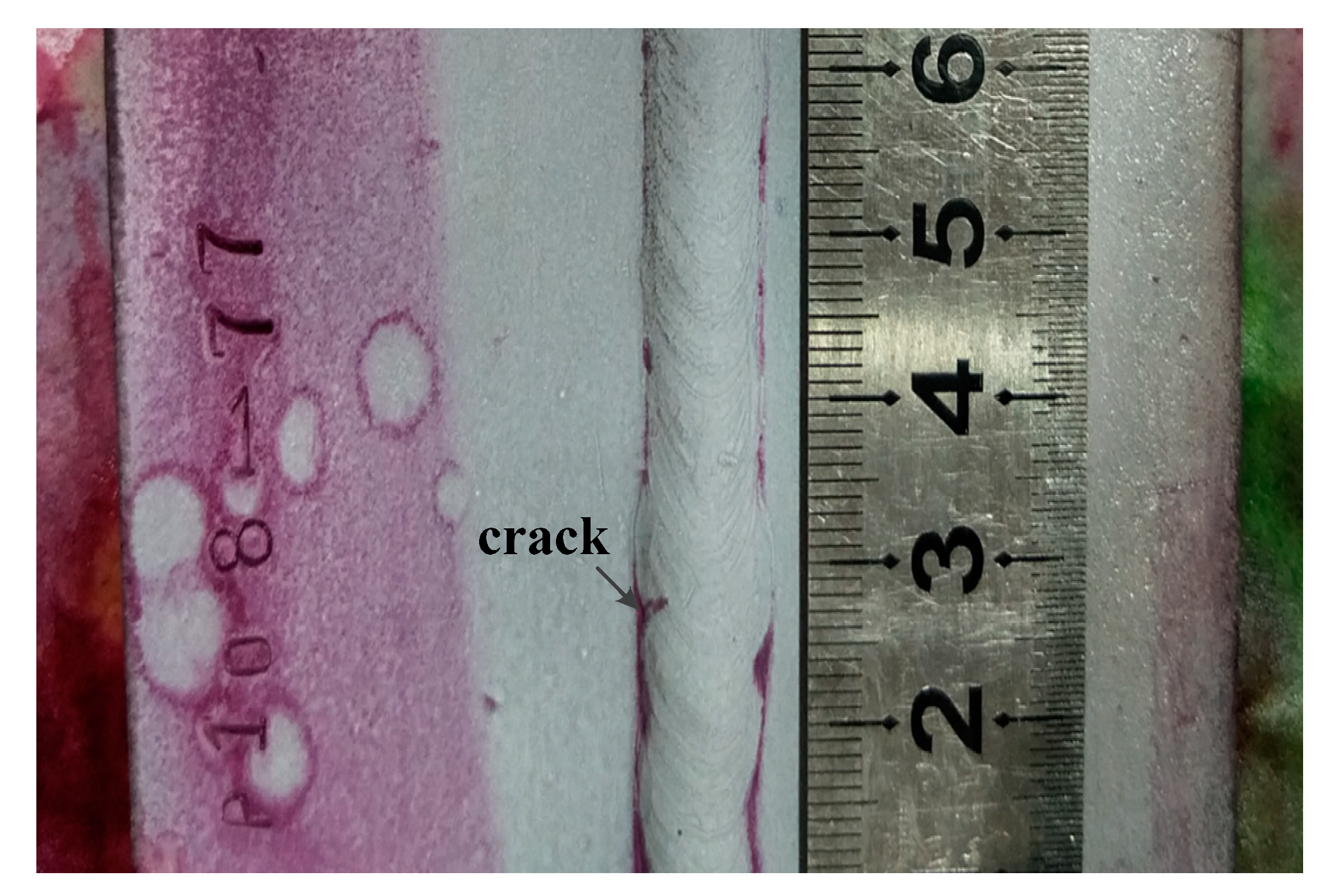

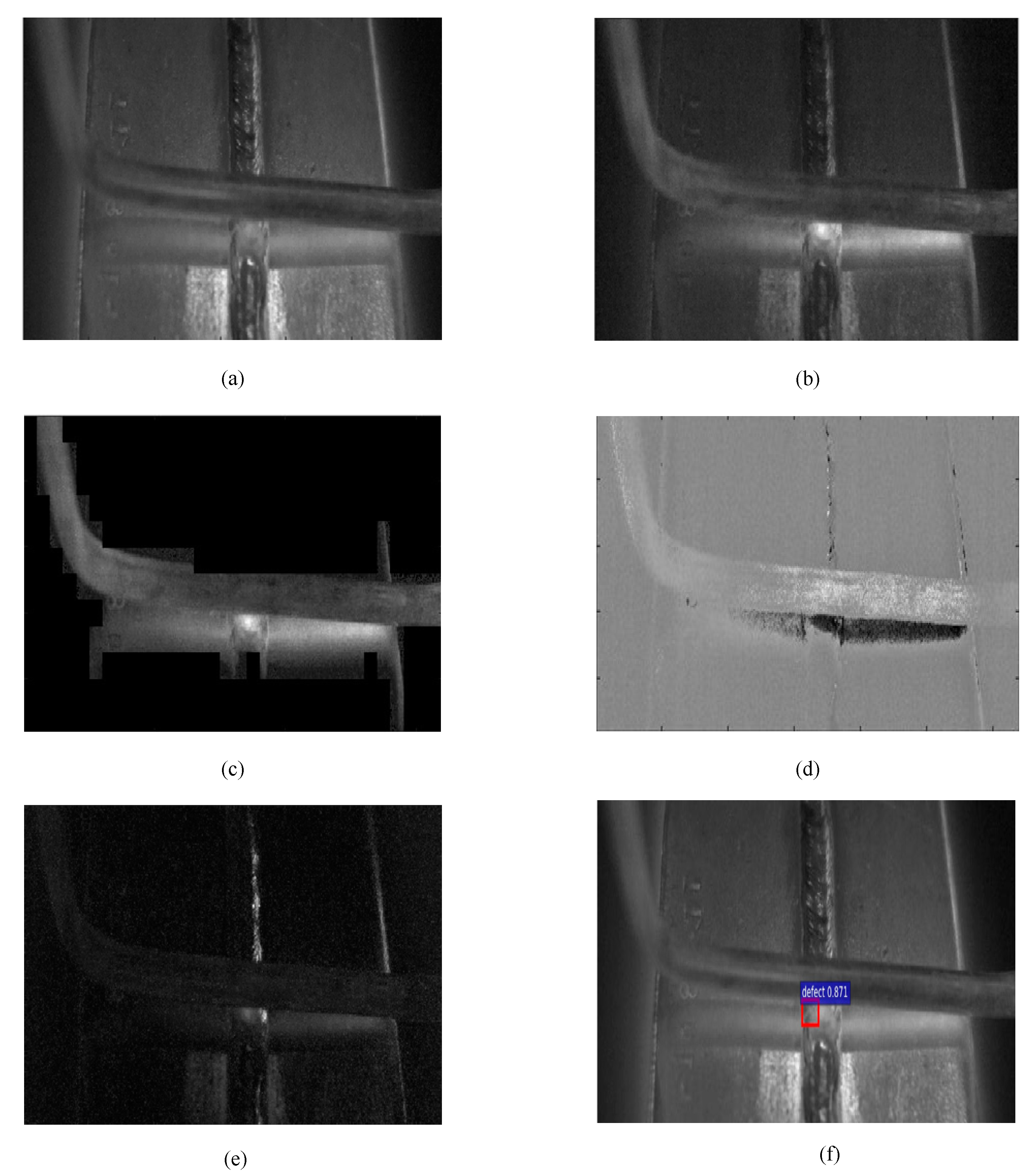
| Hyper-Parameters | Value |
|---|---|
| Batch size | 256 |
| Overlap threshold for ROI | 0.5 |
| Learning Rate | 0.001 |
| Momentum for SGD | 0.9 |
| Weight decay for regularization | 0.0001 |
| Sample | Indication | Dimension | Defect Information | Picture |
|---|---|---|---|---|
| Sample (a) 316# stainless steel | 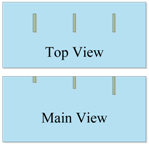 | 120 × 60 × 6 (mm) | 3 types of cracks with different depth (8 × 0.5 × 1.5, 8 × 0.5 × 1.7, 8 × 0.5 × 2 (mm)) notches are manufactured | 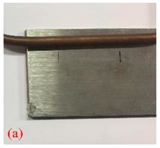 |
| Sample (b) 316# stainless steel |  | 130 × 130 × 10 (mm) | Five 45°-angle man-made cracks (8 × 0.1 × 1 (mm)) | 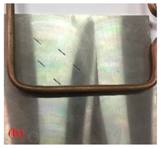 |
| Sample (c) 45# steel |  | 130 × 130 × 10 (mm) | Different angle cracks (0°, 15°, 30°, 45°, 60°, 75°, 90°), the cracks size are all 8 × 0.1 × 1 (mm) | 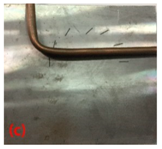 |
| Sample (d) 316# stainless steel |  | 200 × 100 × 18 (mm) | A long natural crack | 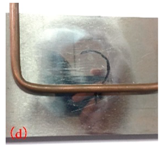 |
| Sample (e) welding line | 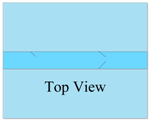 | 150 × 106 × 65 (mm) | Micro natural cracks |  |
| Methods | POD of Different Samples | ||||
|---|---|---|---|---|---|
| Sample (a) | Sample (b) | Sample (c) | Sample (d) | Sample (e) | |
| TSR | 0.42 | 0.40 | 0.29 | 0.10 | 0.00 |
| PPT | 0.33 | 0.30 | 0.43 | 0.10 | 0.00 |
| ARDVB | 0.17 | 0.40 | 0.43 | 0.05 | 0.00 |
| EVBTF | 1.00 | 0.60 | 0.71 | 0.80 | 0.00 |
| SVD-RARX | 1.00 | 1.00 | 0.90 | 0.60 | 0.00 |
| Proposed Method | 1.00 | 1.00 | 1.00 | 0.95 | 0.92 |
| Methods | Evaluation Index | ||
|---|---|---|---|
| TP | FN | POD | |
| TSR | 17 | 58 | 0.23 |
| PPT | 18 | 57 | 0.24 |
| ARDVB | 16 | 59 | 0.21 |
| EVBTF | 49 | 26 | 0.65 |
| SVD-RARX | 53 | 22 | 0.71 |
| Proposed Method | 73 | 2 | 0.97 |
© 2018 by the authors. Licensee MDPI, Basel, Switzerland. This article is an open access article distributed under the terms and conditions of the Creative Commons Attribution (CC BY) license (http://creativecommons.org/licenses/by/4.0/).
Share and Cite
Hu, J.; Xu, W.; Gao, B.; Tian, G.Y.; Wang, Y.; Wu, Y.; Yin, Y.; Chen, J. Pattern Deep Region Learning for Crack Detection in Thermography Diagnosis System. Metals 2018, 8, 612. https://doi.org/10.3390/met8080612
Hu J, Xu W, Gao B, Tian GY, Wang Y, Wu Y, Yin Y, Chen J. Pattern Deep Region Learning for Crack Detection in Thermography Diagnosis System. Metals. 2018; 8(8):612. https://doi.org/10.3390/met8080612
Chicago/Turabian StyleHu, Jue, Weiping Xu, Bin Gao, Gui Yun Tian, Yizhe Wang, Yingchun Wu, Ying Yin, and Juan Chen. 2018. "Pattern Deep Region Learning for Crack Detection in Thermography Diagnosis System" Metals 8, no. 8: 612. https://doi.org/10.3390/met8080612





